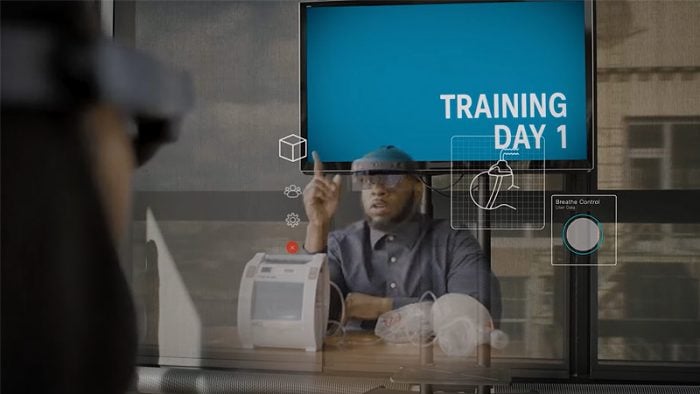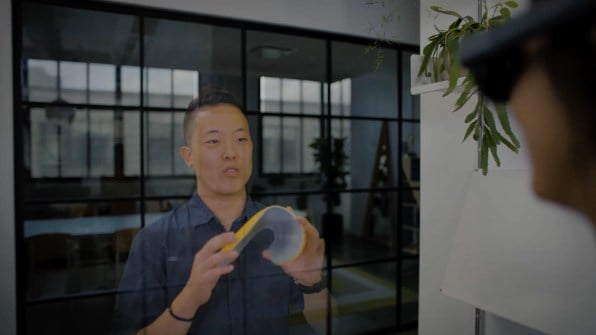Today at Webex One, Cisco gave us a preview of Webex Hologram, a platform that combines the rich features of Webex meetings; with the functionality of immersive 3D holograms.
Harnessing the power of augmented reality (AR), Cisco said it hopes to close the gap between virtual and in-person collaboration. It plans to do so via its new real-time, photorealistic holographic experience which has plenty of real-world applications, including remote training and even resolving technical issues.
Today was merely the unveiling of a preview of Cisco's next-generation hybrid work collaboration product, Webex Hologram. It is the only kind of experience of its kind leveraging Webex meeting technology to enable immersive AR experiences.
According to the Cisco Hybrid Work Index, 64% of employees say if they can't work remotely - they will leave their job. Cisco hopes the release of its AR offering will level that playing field. They also want to make the technology more ubiquitous in collaboration settings.
A platform like the one Cisco built might have previously taken more time to make it to market had we not faced the COVIVD-19 pandemic. The fact is - COVID forced us to take to bleeding-edge technologies to get the job done the best way possible all the while keeping the risk of employees contracting the virus low.
It Could Be A Game Changer for Most Industries
If Cisco manages to get the experience right, then it could be a game-changer for those in most industries. Once AR gets introduced to those like: physicians, technicians, sales, and support teams - the implications for training are massive.
It could speed up the time it takes to train those individuals and reduce money spent on time/travel. For employees, it could enable them to spend more time with family and friends; rather than spending days on the road for a one-day meeting (thousands of miles away).
Webex seems to have its eye on the medical industry, too, writing in a statement:
"While providing the ability to see the surgical device from every angle, it will be as if the physician were in the room."
Rather than flying a technician in for a racing team or explaining procedures using standard images, Webex Hologram could let a technician view an engine from any angle, helping to convey size, and assist in repair, assembly, etc.
Building on Trusted Webex Technology
Over the past year, Webex by Cisco brought almost 1,000 new features and devices to market. Expanding on those features: the new Webex AR technology will have plenty of advanced capabilities when it becomes available. Webex Hologram will also provide a powerful boost to the Webex Suite of collaboration tools and give remote/hybrid workers the chance to have new and exciting workplace encounters.
"Unlike 2D and virtual meeting experiences in the market today, only Webex Hologram enables a feeling of co-presence by delivering photorealistic, real-time holograms of actual people."
Webex notes, for participants, this could mean having an experience that's more engaging and realistic, as opposed to using avatars.
"This can make all the difference when it comes to training and problem-solving."
Looking beyond the experiences, with Webex Hologram, meeting presenters can share both physical and digital content during collaboration sessions. Take an auto manufacturer, for instance; one could presumably interact with a physical prototype of a vehicle in the AR space to run diagnostic tests, examine the vehicle's engine, and even design renderings of the car; itself.
Cisco Webex Hologram creates a multi-dimensional experience for multiple users, while other offerings limit usage to a single angle view. On top of that, the latest from Cisco is headset agnostic, making the Webex Hologram compatible with industry-leading AR headsets, like Magic Leap and Microsoft HoloLens.
AR in Collaboration will be very 'Disruptive'
Any technology that has the power to place employees who are thousands of miles away - side-by-side at the same table with remote colleagues has the potential to be very disruptive. I have already covered many of the implications of said technology in the workplace, but there is more to say about how disruptive it could be.
I will say that Cisco is not the first to introduce such a solution, nor will it; be the last. Research firm; IDC recognizes innovators in the space with an annual award for innovative AR-centric enterprise platforms. Tom Mainelli, Group Vice President of Device and Consumer research at IDC, noted that more companies are going to adopt AR technology to increase process efficiency, continuing:
"It will also facilitate faster knowledge capture and transfer as the role of the AR platform has become increasingly important. Companies want a platform that brings together multiple capabilities that also ensures data remains secure."
Cisco will have to fine-tune its AR technology as it will undoubtedly need work on many fronts. Even though we have come a long with AR technology, we still have a lot of work yet to be done. Today, I have yet to have a (truly) bug-free AR experience or one that was convincing enough to 'replace' in-person meetings but having seen the technology grow in popularity, I understand it is here to stay.
Glitches to be Expected
Nobody who purchased the first iPhone expected it to be glitch-free, and if they did - they quickly learned their lesson. Organizations will have to invest in AR/VR headsets, and choose who gets access to the headsets, too. This could present a new set of complexities for remote device management unless organizations implement a BYOD (bring your (own) device) policy as Cisco has.
Although there are some budget headsets, many are at least $100 so expecting an employee to pick up the tab for such a device is unrealistic.
Outfitting employees with AR headsets will ultimately be the responsibility of the company wanting to leverage the technology, as will proper training on using AR to its fullest. Nobody ever said the future of work would be cheap, but it certainly could be very cool if the folks who need it - gain access to AR/VR headsets for the sake of collaboration.





